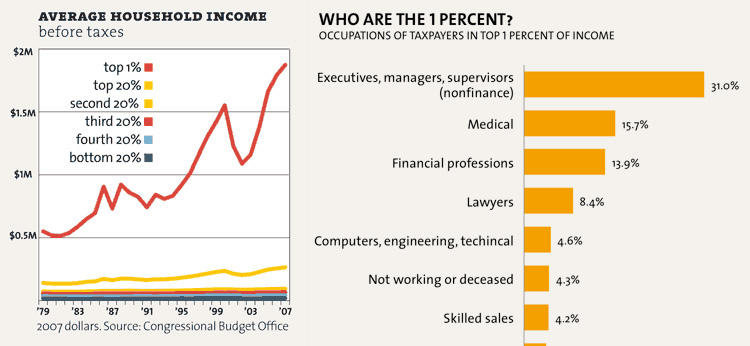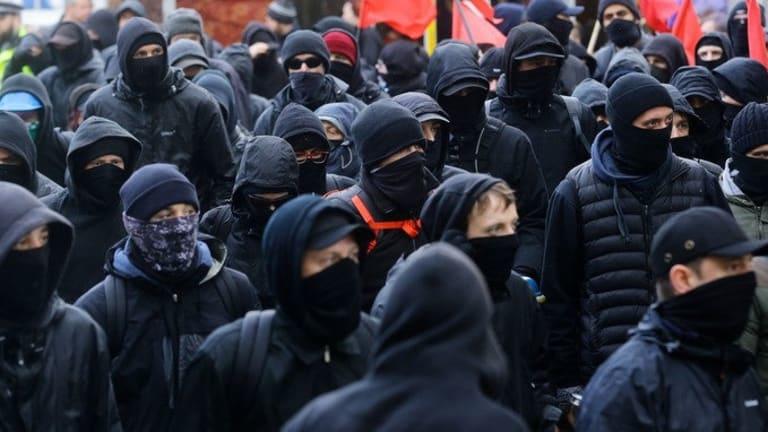A Brief Background
Occupy Wall Street was a protest campaign that started on September 17, 2011, in New York’s Zuccotti Park (Leonhardt). The movement’s main purpose was to draw attention to economic and social inequality and to eliminate the impact of corporations on policy-making. The majority of participants were white young adults who had college educations and were underemployed or unemployed (see fig. 1). Moreover, they had substantial debts that they were unable to pay off.

The movement’s slogan was “We are the 99%.” The motto referred to the inequality of income and distribution of wealth between the top 1% of the United States’ wealthiest citizens and the remaining population (see fig. 2). Hundreds of protesters occupied the park for nearly two months. On November 15, 2011, they were forcibly removed by the New York Police Department (Leonhardt). However, the movement had long-lasting effects that can still be noticed in the US and all over the world.

The statistics of Occupy Wall Street are as follows:
- the age of protestors: 24 and under – 23.5%, 25-44 – 44.5%, 35 and older – 33%, 45 and older – 20%;
- the level of education: college – 60.7%, graduate school – 29.4%, high school or lower – 8%;
- gender: male – 61%, female – 37.5%, other – 1.5%;
- ethnicity: white – 81.2%, Hispanic – 6.8%, Asian – 2.8%, African American – 1.6%, other – 7.6%;
- annual income: between $50,000 and $80,000 – 15%, over $75,000 – 13%, over $150,000 – 2% (“Occupy Wall Street Statistics and Demographics”).
The Movement’s Purpose
Occupy Wall Street was an unprecedented event in the history of the US, as it was the shortest movement that managed to produce such profound outcomes. The campaign attracted much attention from the society and media. The purpose of the movement was to attain equality for US citizens in terms of economic and social relations. According to Moore, Occupy Wall Street managed to achieve its aim since it “struck a new nerve, sending a shock wave” through the country. A few hundred young people who initiated the protest action and participated in it were doing what many millions of citizens had always dreamed of (Moore). Citizens who had lost the “American Dream” and who had no jobs or career prospects proclaimed their desire to change the predominating state of affairs in the country. According to experts, one of the reasons why the movement managed to reach its goal was because it did not follow any strategic pattern (Moore). Protesters did not have a hierarchical organization. Neither did they have a leader, speakers, or structure and responsibilities. Still, the voices of the people were heard, and they were able to make a change they wanted.
The investigation of the movement’s legacy on its second anniversary reiterated the conclusions made by contemporary analysts. Although income inequality had grown, allowing the top 1% of Americans to earn 19% of household income, Occupy Wall Street altered the way “the country talks about the economy” (Wagstaff). The protest helped to ingrain in the national conscience the notion that the existing inequality levels were unacceptable, and that people had the right to demand a change (Wagstaff). Even if the movement did not put an end to global capitalism, it developed some essential talking points. As Wagstaff remarks, the slogan “We are the 99%” had much more power to unite citizens than any lecture could have. According to researchers, the purpose of Occupy Wall Street was reached with the help of unusual approaches and ardent participants who believed in what they were doing and, thus, were convinced that they were doing it right.
Occupy Wall Street and Antifa
Antifa is an anti-fascist movement (hence the name) that is known for its violent and anarchist character (Bryce). The members of this group support communism and express antipathy to capitalism (see fig. 3). They claim to represent an attempt to eradicate the “American Plantation” (Bryce). The representatives of Antifa maintain that slavery exists in every minority community. Still, there are many whites among the group’s members. According to Bryce, the supporters of Antifa want freedom and liberation, but they want these “on their own terms” rather than the way they were defined by the Constitution. Interestingly, although this movement is not peaceful, it is believed to have originated from the nonviolent Occupy Wall Street Movement of 2011 (Bryce). The Occupy movement’s aim was reaching social and economic justice, and Antifa members claim that they are trying to accomplish similar purposes (Bryce). However, it is evident that Antifa’s tactics are far from peaceful, and the group’s militarism puts the lives of its members, as well as the lives of other citizens, at risk. Bryce remarks that while the Occupy Wall Street Movement faded after the 2012 re-election of Obama, it was brought to life again in 2016 upon Trump’s victory (“Shocking! Violent Antifa Protest Dead Woman’s Memorial”). Sadly, the perspectives of Antifa and its predecessor are quite dissimilar.

Some researchers consider the appearance of Antifa to be more than just a consequence of Occupy Wall Street. For instance, Hayward notes that Antifa was a “fringe group reinventing itself as the anti-war movement” in the years of Bush’s presidency, during Occupy Wall Street, in the Black Lives Matter upsurge of 2016, and in its current form. Each time, the representatives of this “fringe group” have had the same organization pattern and used the same networks (Hayward). Therefore, researchers agree that Antifa has its roots in Occupy Wall Street. However, they emphasize that the methods and aims of these movements are not the same. Antifa employs violence and has strong anti-racist positions, whereas Occupy Wall Street strived for social and economic equality for people irrespective of race and ethnicity.
Occupy Wall Street as a Springboard for Other Movements
The popularity of Occupy Wall Street made Americans feel more optimistic and hopeful, which led to the rebirth of such movements as progressivism and radicalism. As a result, one possible consequence is that the protest became a springboard for the renaissance of the US labor movement. As Binh remarks, Occupy Wall Street mobilized “more workers and oppressed people in four weeks than the entire American socialist left has in four decades combined.” Thus the movement grew into an uprising that significantly changed the political landscape of the country. Putting an end to the protest did not destroy its ideas but scattered them all around the country and encouraged oppressed workers to unite their power and promote initiatives that would improve their lives. According to Binh, new movements do not consider themselves successors of Occupy Wall Street, but they would not have appeared without its “heroic example.”
There have been several reflections of the 2011 protest in recent labor movement developments. After Occupy Wall Street, there has been a rise in labor unions’ ethos of “solidarity, collective action and questioning of managerial authority” (Bussel). Initiatives have been undertaken to deal with the existential crisis faced by labor unions. With the help of Occupy Wall Street’s success, these projects offer “glimmerings of hope” that the floundering labor movement can recover its legitimacy and sense of relevance (Bussel). The impact of Occupy Wall Street on the progressive changes in the labor movement is crucial since the events of 2011 helped to draw attention to wealth and income inequality. As a result, attempts have been made at all levels of government in the US to raise the minimum wage, regulate part-time workers’ schedules, and provide paid sick days (Bussel). Therefore, it is fair to say that Occupy Wall Street served as a springboard for the US labor movement’s rebirth.
Works Cited
Binh, Pham. “Occupy: Rebirth of American Radicalism.” The North Star, 2012, Web.
Bryce, Tim. “Where Did Antifa Come from?”Swamp, 2017, Web.
Bussel, Bob. “Rebirth of Progressivism May Breathe New Life in Labor Unions.”The Conversation. 2015, Web.
Hayward, John. “Brandon Darby: Antifa Is the Resurgence of Anti-War Movement, Occupy Wall Street, Black Lives Matter.”Breitbart. 2017, Web.
Leonhardt, Megan. “The Lasting Effects of Occupy Wall Street, Five Years Later.” Money. 2016, Web.
Moore, Michael. “The Purpose of Occupy Wall Street Is to Occupy Wall Street.”. The Nation. 2012, Web.
“A Movement of Numbers: Occupy Wall Street.” The Why Axis. 2011, Web.
“Occupy Wall Street Statistics and Demographics.”Statistic Brain, n.d., Web.
“Shocking! Violent Antifa Protest Dead Woman’s Memorial.” YouTube, uploaded by The Alex Jones Channel. 2017, Web.
Wagstaff, Keith. “Two Years Later: Did Occupy Wall Street Make a Difference?”The Week. 2013, Web.